sensor FORD F-150 2021 Owners Manual
[x] Cancel search | Manufacturer: FORD, Model Year: 2021, Model line: F-150, Model: FORD F-150 2021Pages: 796, PDF Size: 13.89 MB
Page 6 of 796
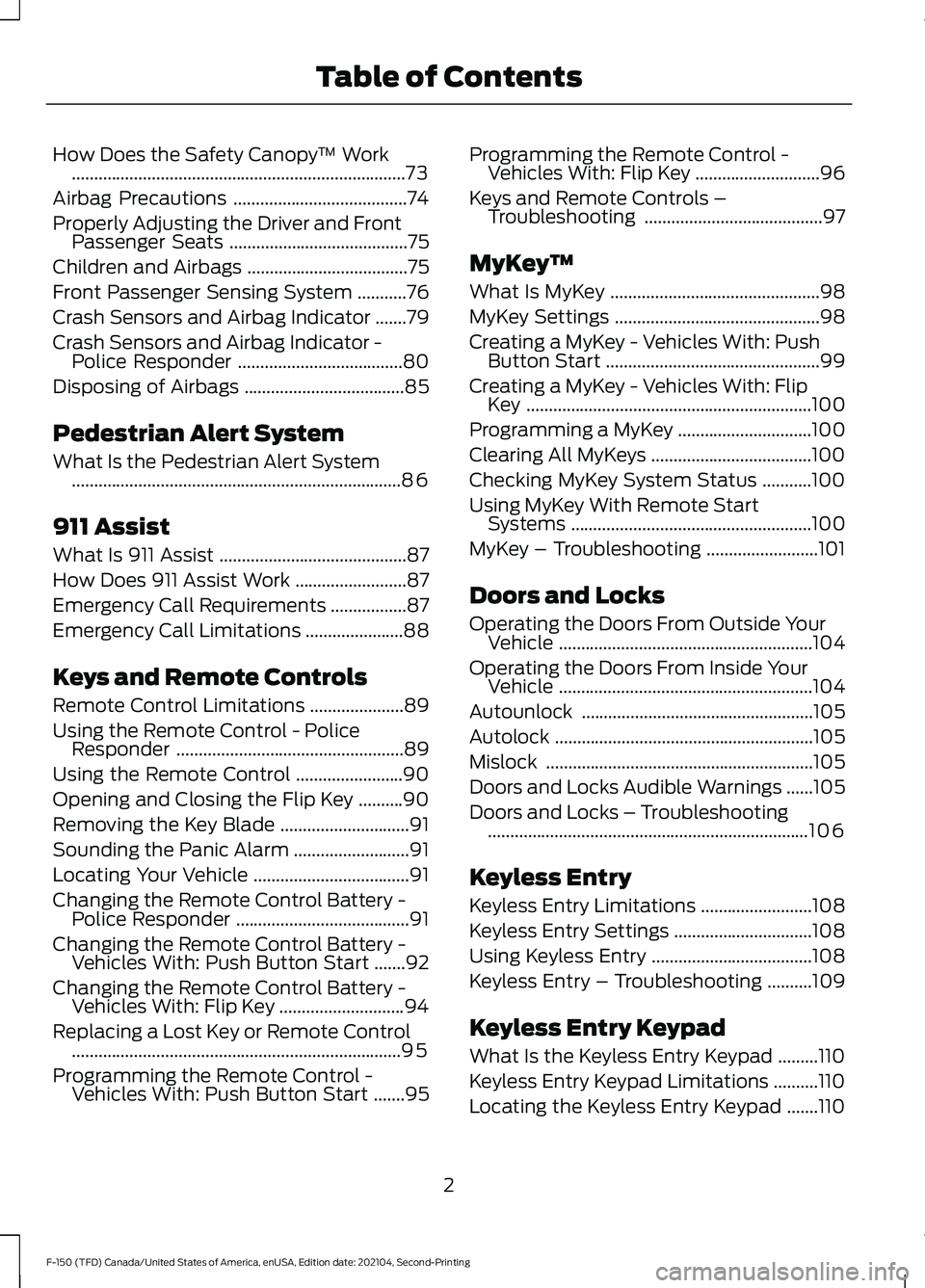
How Does the Safety Canopy
™ Work
........................................................................\
...73
Airbag Precautions .......................................
74
Properly Adjusting the Driver and Front Passenger Seats ........................................
75
Children and Airbags ....................................
75
Front Passenger Sensing System ...........
76
Crash Sensors and Airbag Indicator .......
79
Crash Sensors and Airbag Indicator - Police Responder .....................................
80
Disposing of Airbags ....................................
85
Pedestrian Alert System
What Is the Pedestrian Alert System ........................................................................\
..
86
911 Assist
What Is 911 Assist ..........................................
87
How Does 911 Assist Work .........................
87
Emergency Call Requirements .................
87
Emergency Call Limitations ......................
88
Keys and Remote Controls
Remote Control Limitations .....................
89
Using the Remote Control - Police Responder ...................................................
89
Using the Remote Control ........................
90
Opening and Closing the Flip Key ..........
90
Removing the Key Blade .............................
91
Sounding the Panic Alarm ..........................
91
Locating Your Vehicle ...................................
91
Changing the Remote Control Battery - Police Responder .......................................
91
Changing the Remote Control Battery - Vehicles With: Push Button Start .......
92
Changing the Remote Control Battery - Vehicles With: Flip Key ............................
94
Replacing a Lost Key or Remote Control ........................................................................\
..
95
Programming the Remote Control - Vehicles With: Push Button Start .......
95Programming the Remote Control -
Vehicles With: Flip Key ............................
96
Keys and Remote Controls – Troubleshooting ........................................
97
MyKey ™
What Is MyKey ...............................................
98
MyKey Settings ..............................................
98
Creating a MyKey - Vehicles With: Push Button Start ................................................
99
Creating a MyKey - Vehicles With: Flip Key ................................................................
100
Programming a MyKey ..............................
100
Clearing All MyKeys ....................................
100
Checking MyKey System Status ...........
100
Using MyKey With Remote Start Systems ......................................................
100
MyKey – Troubleshooting .........................
101
Doors and Locks
Operating the Doors From Outside Your Vehicle .........................................................
104
Operating the Doors From Inside Your Vehicle .........................................................
104
Autounlock ....................................................
105
Autolock ..........................................................
105
Mislock ............................................................
105
Doors and Locks Audible Warnings ......
105
Doors and Locks – Troubleshooting ........................................................................\
106
Keyless Entry
Keyless Entry Limitations .........................
108
Keyless Entry Settings ...............................
108
Using Keyless Entry ....................................
108
Keyless Entry – Troubleshooting ..........
109
Keyless Entry Keypad
What Is the Keyless Entry Keypad .........
110
Keyless Entry Keypad Limitations ..........
110
Locating the Keyless Entry Keypad .......
110
2
F-150 (TFD) Canada/United States of America, enUSA, Edition date: 202104, Second-Printing Table of Contents
Page 16 of 796
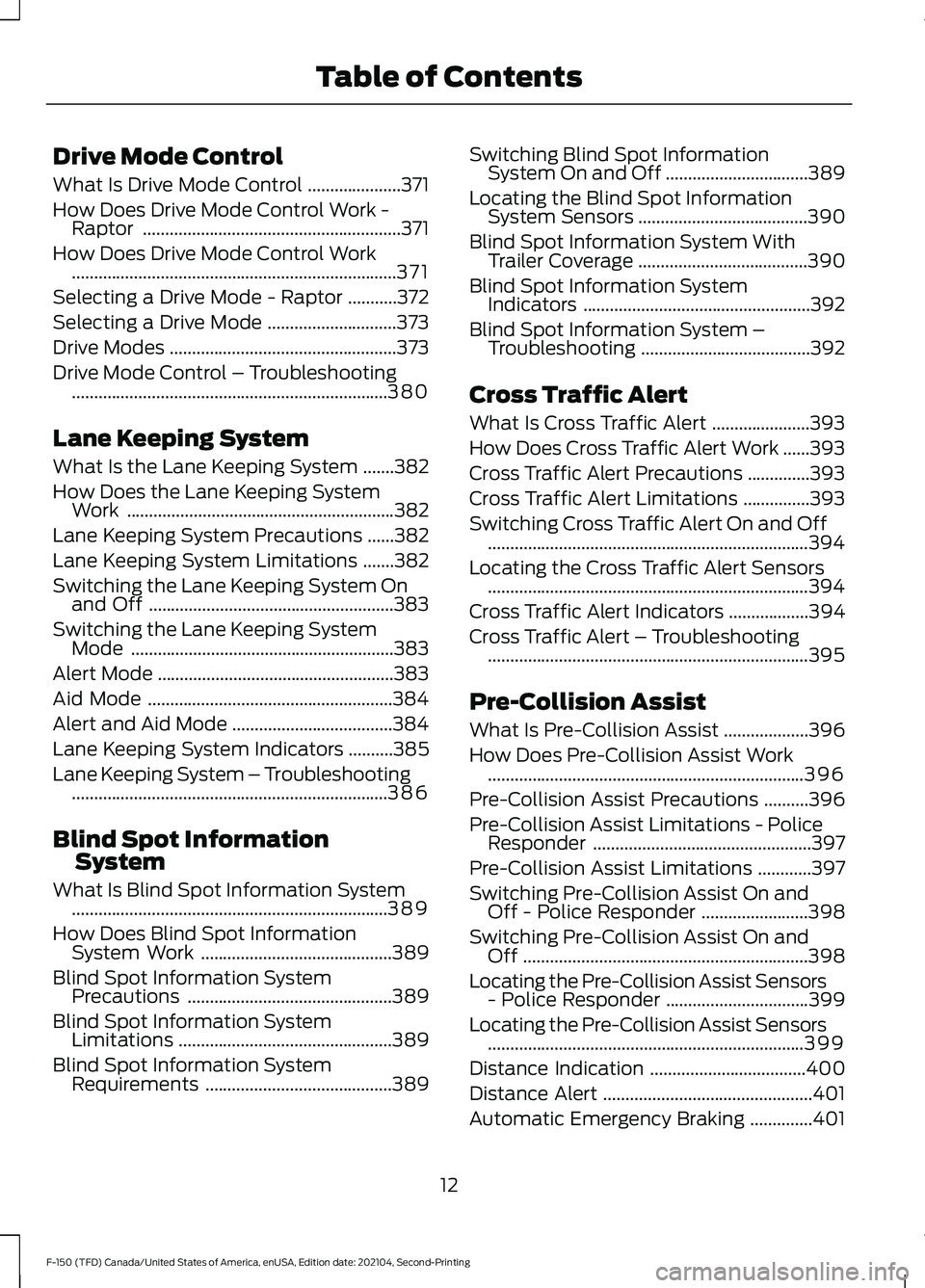
Drive Mode Control
What Is Drive Mode Control
.....................371
How Does Drive Mode Control Work - Raptor ..........................................................
371
How Does Drive Mode Control Work ........................................................................\
.
371
Selecting a Drive Mode - Raptor ...........
372
Selecting a Drive Mode .............................
373
Drive Modes ...................................................
373
Drive Mode Control – Troubleshooting .......................................................................
380
Lane Keeping System
What Is the Lane Keeping System .......
382
How Does the Lane Keeping System Work ............................................................
382
Lane Keeping System Precautions ......
382
Lane Keeping System Limitations .......
382
Switching the Lane Keeping System On and Off .......................................................
383
Switching the Lane Keeping System Mode ...........................................................
383
Alert Mode .....................................................
383
Aid Mode .......................................................
384
Alert and Aid Mode ....................................
384
Lane Keeping System Indicators ..........
385
Lane Keeping System – Troubleshooting .......................................................................
386
Blind Spot Information System
What Is Blind Spot Information System .......................................................................
389
How Does Blind Spot Information System Work ...........................................
389
Blind Spot Information System Precautions ..............................................
389
Blind Spot Information System Limitations ................................................
389
Blind Spot Information System Requirements ..........................................
389Switching Blind Spot Information
System On and Off ................................
389
Locating the Blind Spot Information System Sensors ......................................
390
Blind Spot Information System With Trailer Coverage ......................................
390
Blind Spot Information System Indicators ...................................................
392
Blind Spot Information System – Troubleshooting ......................................
392
Cross Traffic Alert
What Is Cross Traffic Alert ......................
393
How Does Cross Traffic Alert Work ......
393
Cross Traffic Alert Precautions ..............
393
Cross Traffic Alert Limitations ...............
393
Switching Cross Traffic Alert On and Off ........................................................................\
394
Locating the Cross Traffic Alert Sensors ........................................................................\
394
Cross Traffic Alert Indicators ..................
394
Cross Traffic Alert – Troubleshooting ........................................................................\
395
Pre-Collision Assist
What Is Pre-Collision Assist ...................
396
How Does Pre-Collision Assist Work .......................................................................
396
Pre-Collision Assist Precautions ..........
396
Pre-Collision Assist Limitations - Police Responder .................................................
397
Pre-Collision Assist Limitations ............
397
Switching Pre-Collision Assist On and Off - Police Responder ........................
398
Switching Pre-Collision Assist On and Off ................................................................
398
Locating the Pre-Collision Assist Sensors - Police Responder ................................
399
Locating the Pre-Collision Assist Sensors .......................................................................
399
Distance Indication ...................................
400
Distance Alert ...............................................
401
Automatic Emergency Braking ..............
401
12
F-150 (TFD) Canada/United States of America, enUSA, Edition date: 202104, Second-Printing Table of Contents
Page 37 of 796
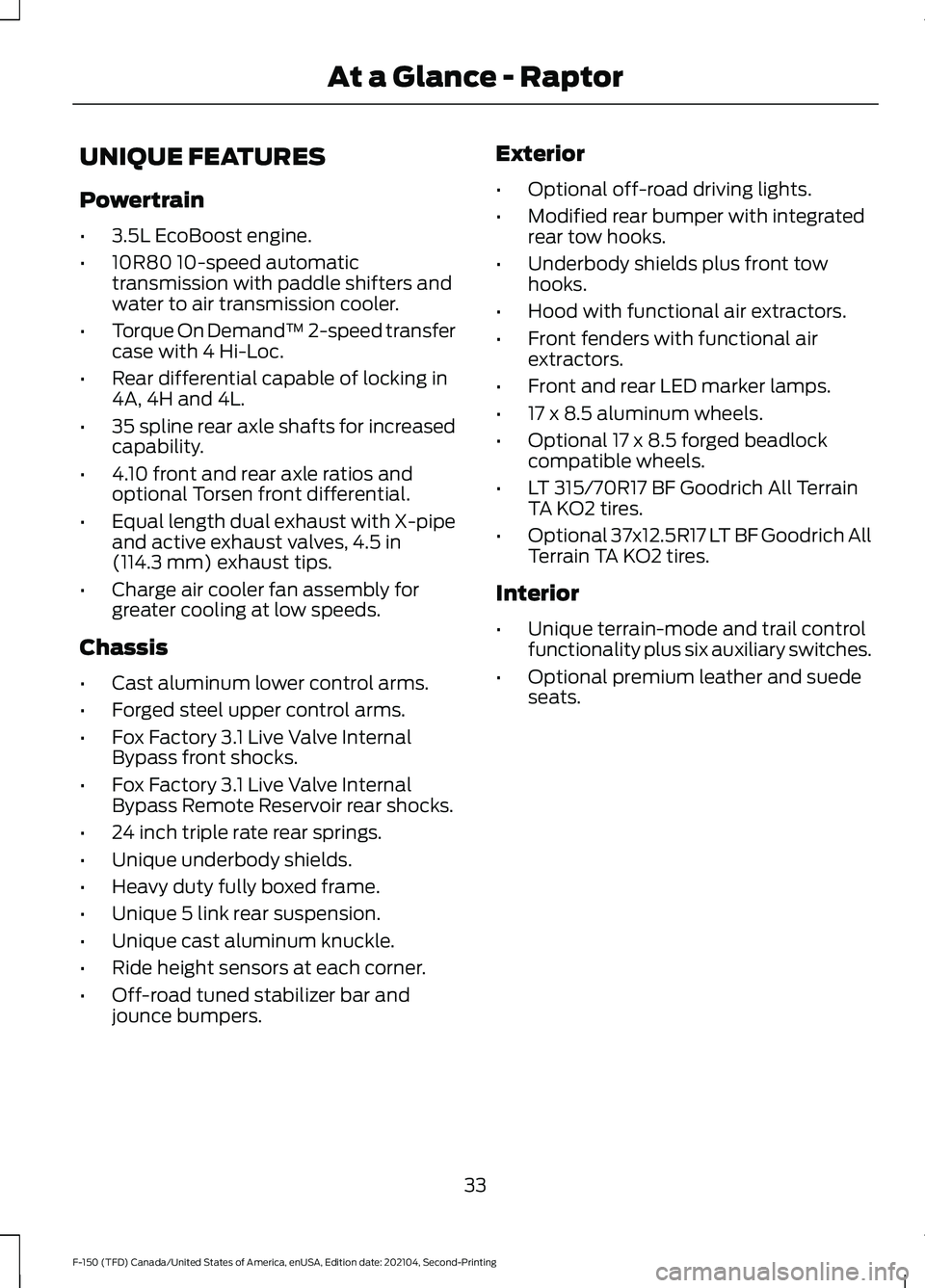
UNIQUE FEATURES
Powertrain
•
3.5L EcoBoost engine.
• 10R80 10-speed automatic
transmission with paddle shifters and
water to air transmission cooler.
• Torque On Demand™ 2-speed transfer
case with 4 Hi-Loc.
• Rear differential capable of locking in
4A, 4H and 4L.
• 35 spline rear axle shafts for increased
capability.
• 4.10 front and rear axle ratios and
optional Torsen front differential.
• Equal length dual exhaust with X-pipe
and active exhaust valves, 4.5 in
(114.3 mm) exhaust tips.
• Charge air cooler fan assembly for
greater cooling at low speeds.
Chassis
• Cast aluminum lower control arms.
• Forged steel upper control arms.
• Fox Factory 3.1 Live Valve Internal
Bypass front shocks.
• Fox Factory 3.1 Live Valve Internal
Bypass Remote Reservoir rear shocks.
• 24 inch triple rate rear springs.
• Unique underbody shields.
• Heavy duty fully boxed frame.
• Unique 5 link rear suspension.
• Unique cast aluminum knuckle.
• Ride height sensors at each corner.
• Off-road tuned stabilizer bar and
jounce bumpers. Exterior
•
Optional off-road driving lights.
• Modified rear bumper with integrated
rear tow hooks.
• Underbody shields plus front tow
hooks.
• Hood with functional air extractors.
• Front fenders with functional air
extractors.
• Front and rear LED marker lamps.
• 17 x 8.5 aluminum wheels.
• Optional 17 x 8.5 forged beadlock
compatible wheels.
• LT 315/70R17 BF Goodrich All Terrain
TA KO2 tires.
• Optional 37x12.5R17 LT BF Goodrich All
Terrain TA KO2 tires.
Interior
• Unique terrain-mode and trail control
functionality plus six auxiliary switches.
• Optional premium leather and suede
seats.
33
F-150 (TFD) Canada/United States of America, enUSA, Edition date: 202104, Second-Printing At a Glance - Raptor
Page 50 of 796
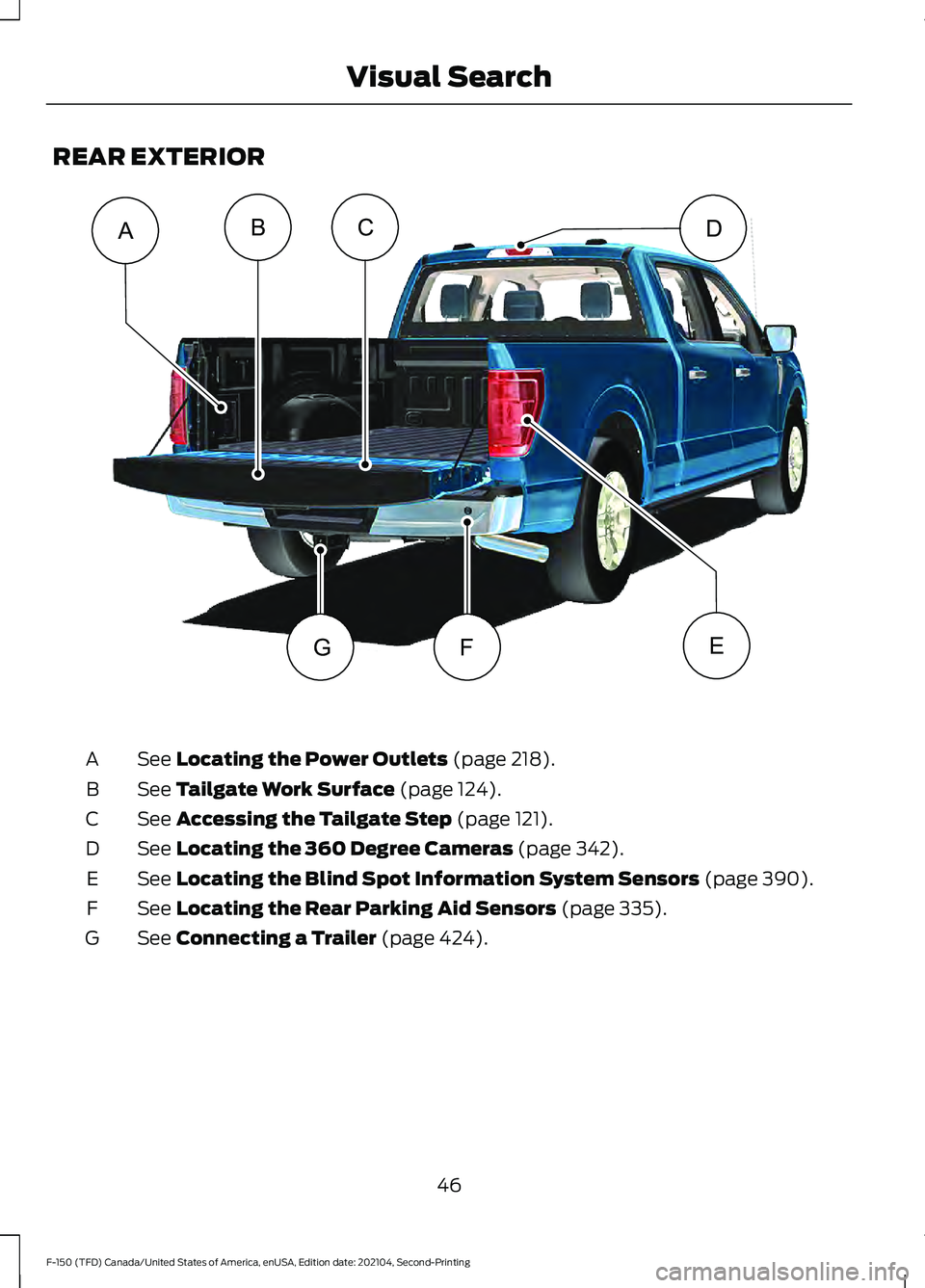
REAR EXTERIOR
See Locating the Power Outlets (page 218).
A
See
Tailgate Work Surface (page 124).
B
See
Accessing the Tailgate Step (page 121).
C
See
Locating the 360 Degree Cameras (page 342).
D
See
Locating the Blind Spot Information System Sensors (page 390).
E
See
Locating the Rear Parking Aid Sensors (page 335).
F
See
Connecting a Trailer (page 424).
G
46
F-150 (TFD) Canada/United States of America, enUSA, Edition date: 202104, Second-Printing Visual SearchABCD
EFGE320171
Page 51 of 796
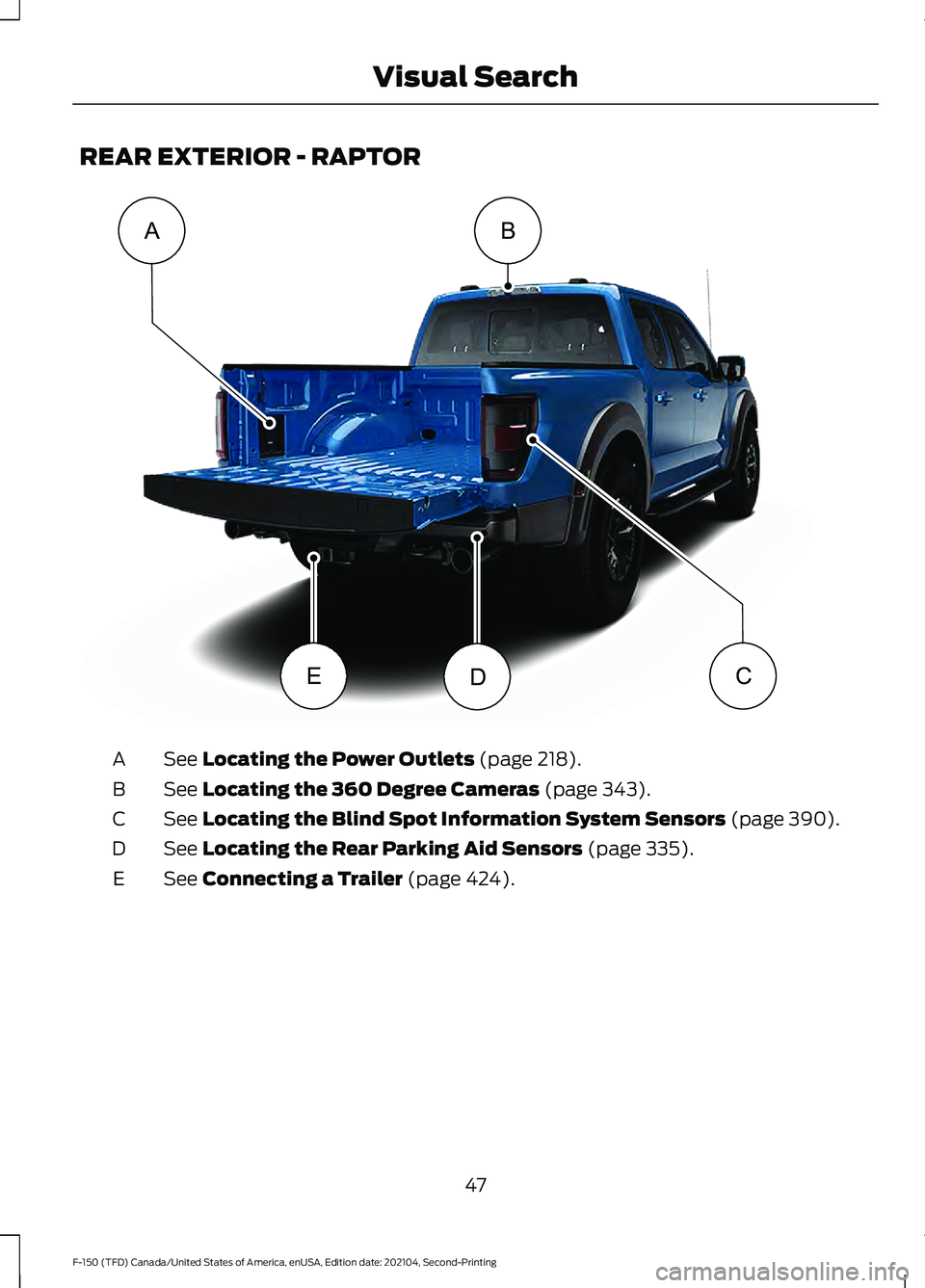
REAR EXTERIOR - RAPTOR
See Locating the Power Outlets (page 218).
A
See
Locating the 360 Degree Cameras (page 343).
B
See
Locating the Blind Spot Information System Sensors (page 390).
C
See
Locating the Rear Parking Aid Sensors (page 335).
D
See
Connecting a Trailer (page 424).
E
47
F-150 (TFD) Canada/United States of America, enUSA, Edition date: 202104, Second-Printing Visual SearchA
CDE
BE343521
Page 52 of 796

REAR EXTERIOR - POLICE RESPONDER
See Opening the Tailgate From Outside Your Vehicle (page 113). See
Opening the Tailgate From Outside Your Vehicle (page 119). See Opening
the Tailgate From Outside Your Vehicle
(page 127).
A
See
Locating the 360 Degree Cameras (page 342).
B
See
Locating the Blind Spot Information System Sensors (page 390).
C
See
Locating the Rear Parking Aid Sensors (page 335).
D
See
Connecting a Trailer (page 424).
E
48
F-150 (TFD) Canada/United States of America, enUSA, Edition date: 202104, Second-Printing Visual SearchA
CDE
BE343534
Page 68 of 796
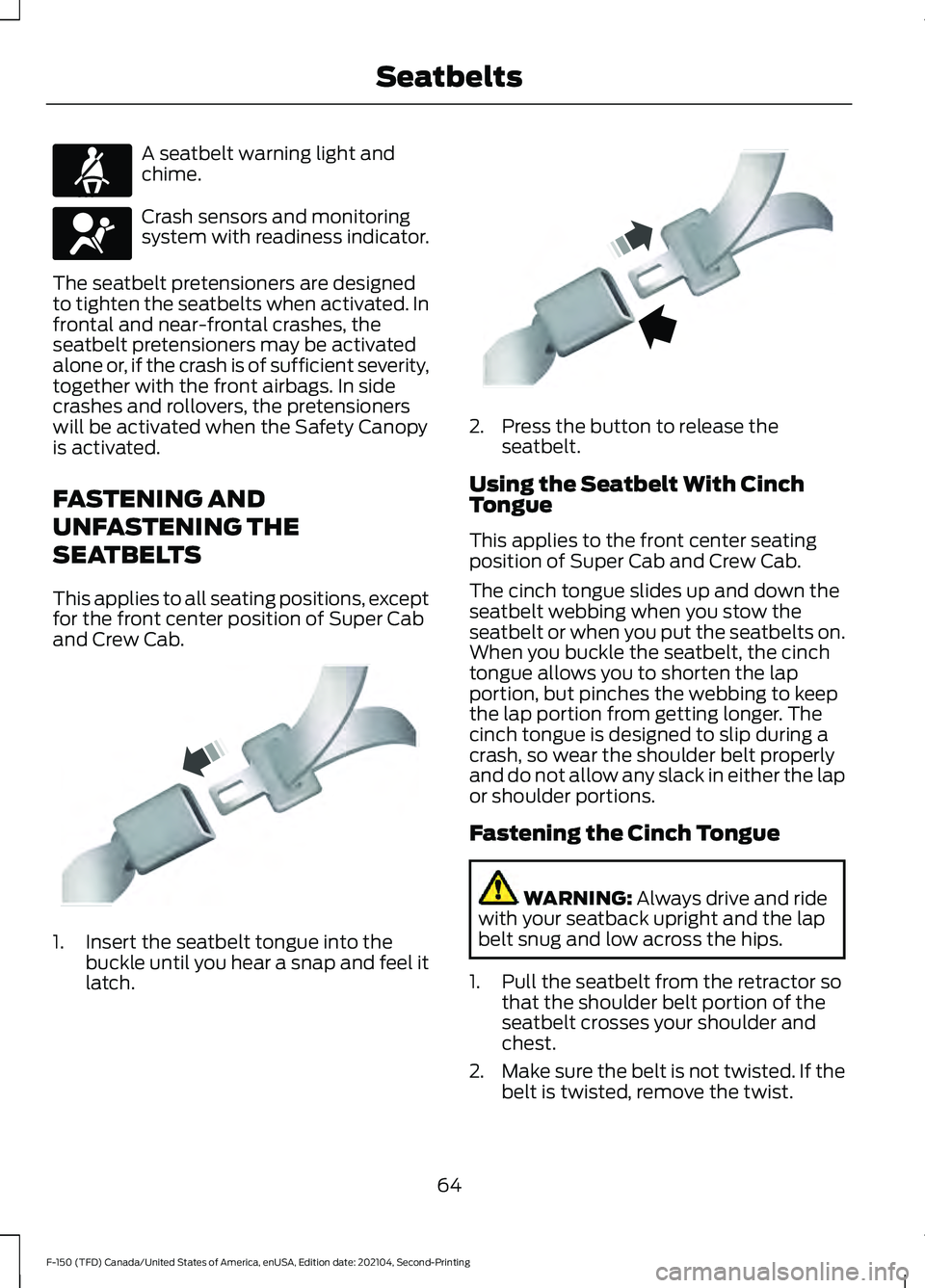
A seatbelt warning light and
chime.
Crash sensors and monitoring
system with readiness indicator.
The seatbelt pretensioners are designed
to tighten the seatbelts when activated. In
frontal and near-frontal crashes, the
seatbelt pretensioners may be activated
alone or, if the crash is of sufficient severity,
together with the front airbags. In side
crashes and rollovers, the pretensioners
will be activated when the Safety Canopy
is activated.
FASTENING AND
UNFASTENING THE
SEATBELTS
This applies to all seating positions, except
for the front center position of Super Cab
and Crew Cab. 1. Insert the seatbelt tongue into the
buckle until you hear a snap and feel it
latch. 2. Press the button to release the
seatbelt.
Using the Seatbelt With Cinch
Tongue
This applies to the front center seating
position of Super Cab and Crew Cab.
The cinch tongue slides up and down the
seatbelt webbing when you stow the
seatbelt or when you put the seatbelts on.
When you buckle the seatbelt, the cinch
tongue allows you to shorten the lap
portion, but pinches the webbing to keep
the lap portion from getting longer. The
cinch tongue is designed to slip during a
crash, so wear the shoulder belt properly
and do not allow any slack in either the lap
or shoulder portions.
Fastening the Cinch Tongue WARNING: Always drive and ride
with your seatback upright and the lap
belt snug and low across the hips.
1. Pull the seatbelt from the retractor so that the shoulder belt portion of the
seatbelt crosses your shoulder and
chest.
2. Make sure the belt is not twisted. If the
belt is twisted, remove the twist.
64
F-150 (TFD) Canada/United States of America, enUSA, Edition date: 202104, Second-Printing SeatbeltsE71880 E67017 E142587 E142588
Page 75 of 796
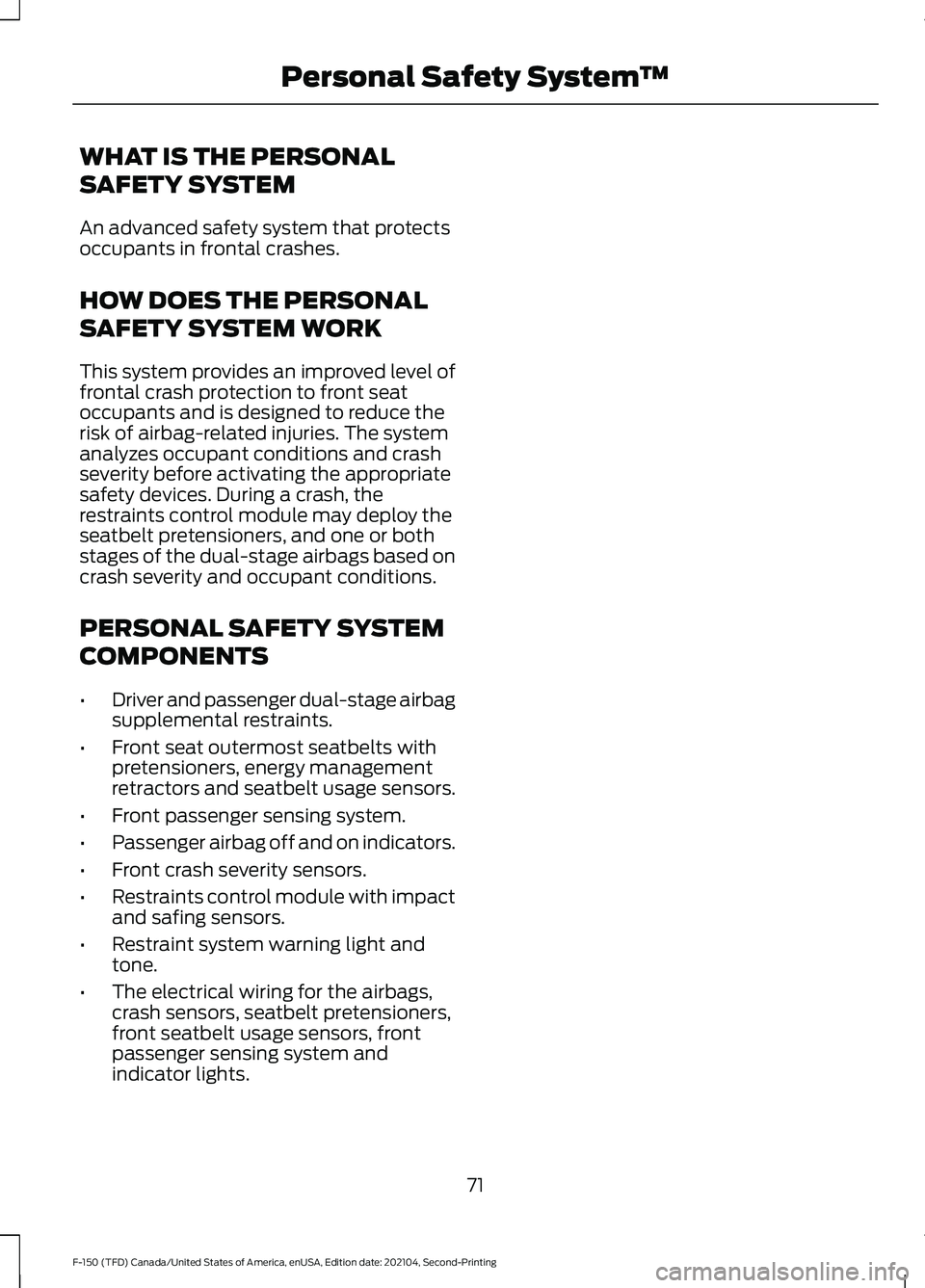
WHAT IS THE PERSONAL
SAFETY SYSTEM
An advanced safety system that protects
occupants in frontal crashes.
HOW DOES THE PERSONAL
SAFETY SYSTEM WORK
This system provides an improved level of
frontal crash protection to front seat
occupants and is designed to reduce the
risk of airbag-related injuries. The system
analyzes occupant conditions and crash
severity before activating the appropriate
safety devices. During a crash, the
restraints control module may deploy the
seatbelt pretensioners, and one or both
stages of the dual-stage airbags based on
crash severity and occupant conditions.
PERSONAL SAFETY SYSTEM
COMPONENTS
•
Driver and passenger dual-stage airbag
supplemental restraints.
• Front seat outermost seatbelts with
pretensioners, energy management
retractors and seatbelt usage sensors.
• Front passenger sensing system.
• Passenger airbag off and on indicators.
• Front crash severity sensors.
• Restraints control module with impact
and safing sensors.
• Restraint system warning light and
tone.
• The electrical wiring for the airbags,
crash sensors, seatbelt pretensioners,
front seatbelt usage sensors, front
passenger sensing system and
indicator lights.
71
F-150 (TFD) Canada/United States of America, enUSA, Edition date: 202104, Second-Printing Personal Safety System
™
Page 76 of 796

HOW DO THE FRONT AIRBAGS
WORK
The driver and front passenger airbags
deploy during significant frontal and near
frontal crashes.
The driver and passenger front airbag
system consists of:
•
Driver and passenger airbag modules.
• Front passenger sensing system.
• Crash sensors and monitoring system
with readiness indicator. See Crash
Sensors and Airbag Indicator (page
79
).
The airbags are a supplemental restraint
system and are designed to work with the
seatbelts to help protect the driver and
right front passenger from certain upper
body injuries. Airbags do not inflate slowly;
there is a risk of injury from a deploying
airbag.
Note: You will hear a loud bang and see a
cloud of harmless powdery residue if an
airbag deploys. This is normal.
The airbags inflate and deflate rapidly
upon activation. After airbag deployment,
it is normal to notice a smoke-like, powdery
residue or smell the burnt propellant. This
may consist of cornstarch, talcum powder
(to lubricate the bag) or sodium compounds (for example, baking soda)
that result from the combustion process
that inflates the airbag. Small amounts of
sodium hydroxide may be present which
may irritate the skin and eyes, but none of
the residue is toxic.
Contact with a deploying airbag may cause
abrasions or swelling. Temporary hearing
loss is also a possibility as a result of the
noise associated with a deploying airbag.
Because airbags must inflate rapidly and
with considerable force, there is the risk of
death or serious injuries such as fractures,
facial and eye injuries or internal injuries,
particularly to occupants who are not
properly restrained or are otherwise out of
position at the time of airbag deployment.
Thus, it is extremely important that
occupants be properly restrained as far
away from the airbag module as possible
while maintaining vehicle control.
Routine maintenance of the airbags is not
required.
HOW DO THE SIDE AIRBAGS
WORK
WARNING:
Do not place objects
or mount equipment on or near the
airbag cover, on the side of the front or
rear seatbacks, or in areas that may
come into contact with a deploying
airbag. Failure to follow these
instructions may increase the risk of
personal injury in the event of a crash. WARNING:
Accessory seat covers
not released by Ford Motor Company
could prevent the deployment of the
airbags and increase the risk of injuries
in a crash.
72
F-150 (TFD) Canada/United States of America, enUSA, Edition date: 202104, Second-Printing AirbagsE151127
Page 77 of 796
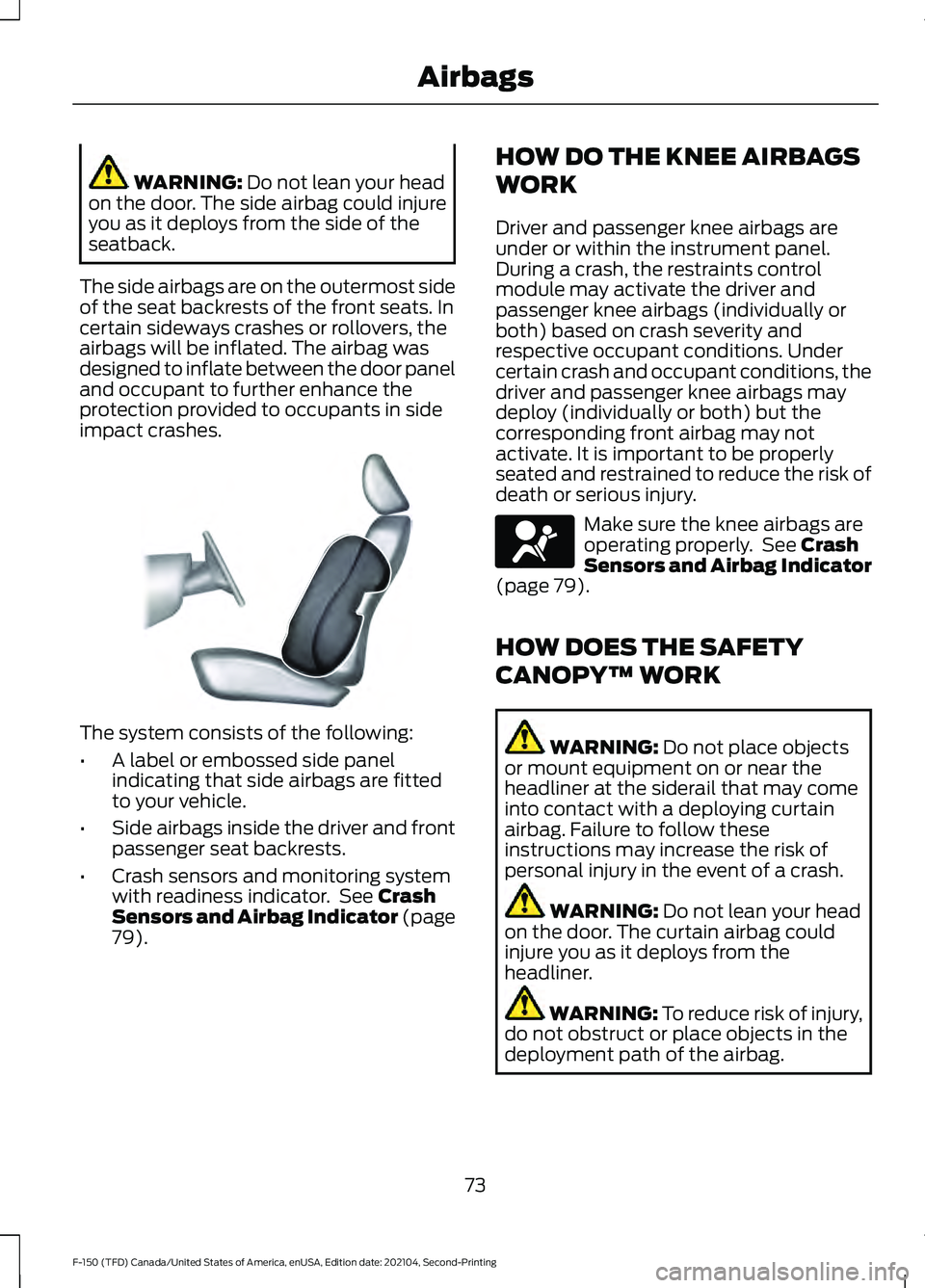
WARNING: Do not lean your head
on the door. The side airbag could injure
you as it deploys from the side of the
seatback.
The side airbags are on the outermost side
of the seat backrests of the front seats. In
certain sideways crashes or rollovers, the
airbags will be inflated. The airbag was
designed to inflate between the door panel
and occupant to further enhance the
protection provided to occupants in side
impact crashes. The system consists of the following:
•
A label or embossed side panel
indicating that side airbags are fitted
to your vehicle.
• Side airbags inside the driver and front
passenger seat backrests.
• Crash sensors and monitoring system
with readiness indicator. See
Crash
Sensors and Airbag Indicator (page
79
). HOW DO THE KNEE AIRBAGS
WORK
Driver and passenger knee airbags are
under or within the instrument panel.
During a crash, the restraints control
module may activate the driver and
passenger knee airbags (individually or
both) based on crash severity and
respective occupant conditions. Under
certain crash and occupant conditions, the
driver and passenger knee airbags may
deploy (individually or both) but the
corresponding front airbag may not
activate. It is important to be properly
seated and restrained to reduce the risk of
death or serious injury.
Make sure the knee airbags are
operating properly. See
Crash
Sensors and Airbag Indicator
(page
79).
HOW DOES THE SAFETY
CANOPY™ WORK WARNING:
Do not place objects
or mount equipment on or near the
headliner at the siderail that may come
into contact with a deploying curtain
airbag. Failure to follow these
instructions may increase the risk of
personal injury in the event of a crash. WARNING:
Do not lean your head
on the door. The curtain airbag could
injure you as it deploys from the
headliner. WARNING:
To reduce risk of injury,
do not obstruct or place objects in the
deployment path of the airbag.
73
F-150 (TFD) Canada/United States of America, enUSA, Edition date: 202104, Second-Printing AirbagsE152533 E67017